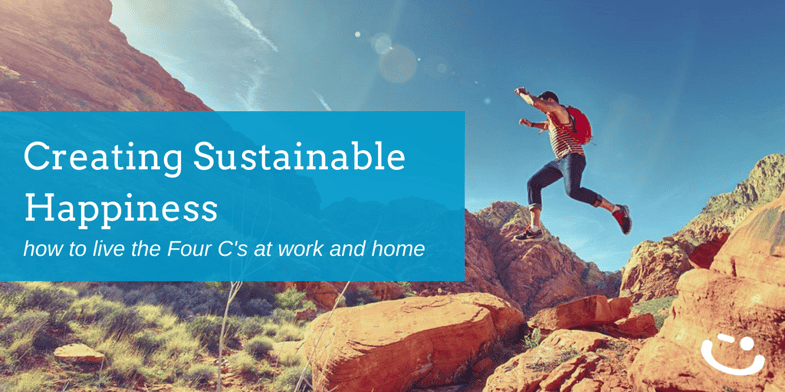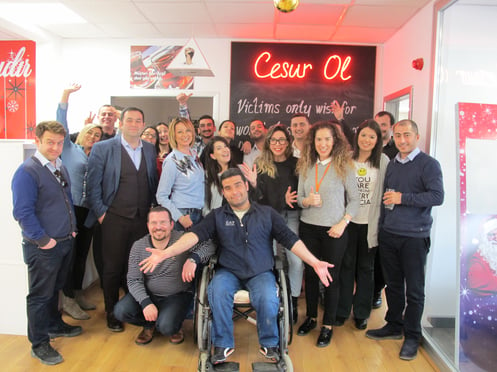
In our previous post, we explored the differences between happiness and pleasure and why it matters at work. We learned about the role of serotonin in happiness and dopamine in pleasure and how to tell the difference between the two. Research from the 2017 book by Dr. Robert Lustig helped inform our understanding of these two neurotransmitters and their effects on human health and behavior. Lastly, we included an infographic that illustrated how our workplaces could enhance both happiness and pleasure.
This article revisits Dr. Lustig’s work and his solution to chronic unhappiness (i.e., dopamine imbalance, which can lead to addiction). He calls his solution the 4 C’s of Happiness: Connect, Contribute, Cope, and Cook. We will review the 4 C’s and then discuss their business and cultural implications.
The Four C's: a Deeper Dive
1) Connect with people whose company you enjoy. Do this in-person, face-to-face. Some things you can do:
The sky’s the limit for things you could do, just put down the phone and do it! Connecting can also generate empathy, a form of emotional intelligence, which is instrumental in relationships and career success.
Time spent with animals can also be restorative; a growing number of organizations acknowledge this via pet-friendly offices. My hypothesis is that pets in the workplace (when done properly) can generate higher serotonin levels in staff, which boosts individual morale and team cohesion (but I haven’t seen any data to confirm this yet).
For my fellow HSP readers, empaths, and introverts, don’t forget to spend time connecting with yourselves. :)
2) Contribute to something larger than yourself. The key is to use your time, energy, resources, and attention to make the world a better place. I love what Saint Francis of Assisi said, “It is in giving that we receive.”
Many nonprofits survive by volunteers’ contributions of time and money. A growing number of businesses, such as certified B Corps, integrate social and environmental aspects into their corporate mission statements to use “business as a force for good.” Not surprisingly, many people want to work for purpose-driven companies.
3) Cope with the stresses of life in three areas.
4) Cook: We all know that it’s important to eat well. But the inverse also holds true: health also means not eating foods and additives that degrade your body and brain. Countless scientists and authors have made this clear, including Dr. Lustig in his New York Times bestseller, Fat Chance: Beating the Odds Against Sugar, Processed Food, Obesity, and Disease.
We’re all the same, yet all a little different. Find out what foods work best for you. One of my favorite guidelines is to Eat the Rainbow.
For anyone interested in using food to improve your mood and energy levels, understand the role of neurotransmitters in your mood, and live a generally healthier life, I heartily recommend The Mood Cure by Julia Ross.
In summary: Connect, Contribute, Cope, and Cook.
Four C’s might sound like a lot, but we naturally combine them all the time. Here are a few examples:
How can you use the 4 C's in business culture?
Now let’s apply our understanding of the 4 C’s to business. If a business wants to survive and grow, it must foster the happiness and pleasure of its customers and employees. Here are two examples of businesses that have done just that, using the lens of the four 4 C’s.
1) Alamo Drafthouse - Connecting moviegoers via fun, shared movie experiences
Most of us watch TV and movies at home. We tend to watch for pleasure (to alleviate boredom, be mentally stimulated, etc.). Have you noticed the difference between watching TV alone vs. experiencing it with a friend, or communally at a theater or in concert?

Humans are wired for shared social experiences. Our early human ancestors in Africa would gather around fires to cook and share food (inducing dopamine and serotonin) and strengthen group bonds and identity through storytelling. These rituals were immensely beneficial to human survival and development, and they became wired into our brains, bodies, and behavior. It is no coincidence that Amazon chose to name its content streaming device the Fire Stick. For readers interested in this topic, I recommend E.O. Wilson’s The Social Conquest of Earth and the Netflix documentary series Cooked with Michael Pollan.
Fast forward to the modern day. The prehistoric fires that served as social hubs have evolved into new forms. One form is movies. Sure, we can watch movies at home alone, and we often do. However, we are wired to derive happiness from this same activity if we experience it within a group setting of like-minded people.
The business opportunity is to create a culture that facilitates feelings of happiness in a safe, pleasant, and comfortable space. Feelings of safety and comfort lower cortisol, the stress hormone. This improves our overall well-being.
Alamo Drafthouse gets this. It has made it's business a place of delightful experiences for customers and staff. For instance, Alamo hosts immersive theme nights for movie premieres. For the premier of Black Panther, it featured a themed food and beverage menu, fun movie props for photo ops, and encouraged moviegoers and staff to dress in costume.
2) Canpa- Contributing to team morale and goodwill via employee appreciation
Reflect back again on our prehistoric campfire, burning late into the night sky. Part of this social ritual was the sharing of food, both hunted and foraged. There was giving and taking, and as a result, the group could survive and prosper. Over time, cooperation, sharing, reciprocity, and other prosocial behaviors became written into our DNA.
If you’re reading this, you probably have access to the basic needs of food, water, and shelter. You have non-physical needs, too, like recognition and praise. Such appreciations affirm our value to a group. These social habits and rituals were necessary to our prehistoric survival, and they remain vital to the long-term success of any organization or group.
Canpa, a construction materials company based in Turkey, now carries the torch of this ancient custom. After attending a Delivering Happiness masterclass, Canpa’s leadership created new traditions as part of its cultural transformation.
Now, every team meeting opens with the giving of praise, inspirational notions, and heartfelt compliments to one team member. A new person is chosen for each meeting so that the opportunity for happiness is shared. Simple gestures like this cost nothing, yet they can have powerful emotional and health benefits that elevate group cohesion and performance.

So how can you integrate these insights into your company culture? DH offers coachsulting [coaching + consulting] services to help guide your workplace towards your ideal culture:
A note from the author…
As I noted in my previous article … In full transparency, I do not receive anything for recommending any books, articles, or media.